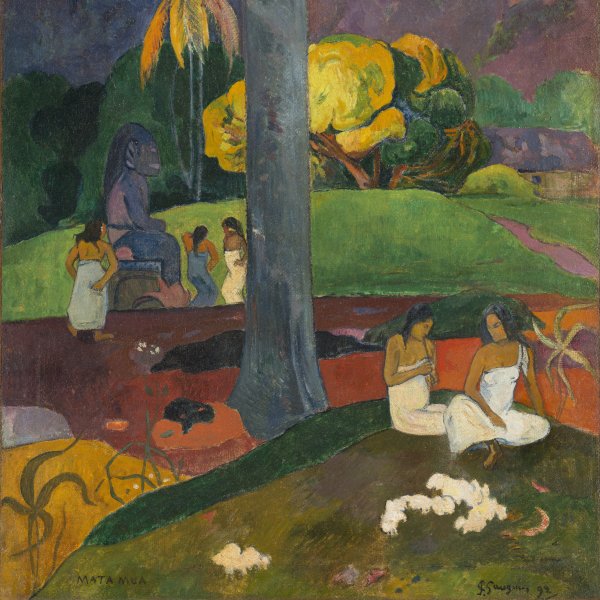Two Breton Women under an Apple Tree in Flower
1892
Oil on canvas.
73.5 x 60.5 cm
Carmen Thyssen Collection
Inv. no. (
CTB.1998.45
)
ROOM F
Level 0
Carmen Thyssen Collection and Temporary exhibition rooms
In the summer of 1888, the young Sérusier visited the village of Pont-Aven in Brittany. There he met Gauguin, the leader of a small group of artists, and approached him to ask his advice. In an area of woodland close to Pont-Aven, Sérusier painted a small landscape on the lid of a cigar box, following Gauguin's instructions: "How do you see that tree? [...] Is it green? Then use green, the most beautiful green in your palette. And that shadow: it's really rather blue? Don't be afraid to paint it as blue as possible." Back in Paris, Sérusier showed his friends at the Académie Julian the almost abstract landscape, The Talisman, painted with pure colours straight out of the tube, with scarcely any mixture of white. He thus revealed to them his new theory of the painting as a "flat surface covered with colours assembled in a certain order." This revelation was to give rise to the Nabis group of painters, whose members included Denis, Bonnard, Vuillard and Ranson. Throughout the 1890s, Sérusier enjoyed great prestige among the Nabis as an intellectual and philosopher; it was said that he knew not only Latin but also Arabic and Hebrew, that he read the Neo-Platonic philosopher Plotinus, that he was well-versed in theosophy and in Catholic theology, and more.
At the same time, and following Gauguin's departure for the South Seas in 1891, Sérusier remained in contact with the Pont-Aven group during his long stays in Brittany. He considered this region his true spiritual home and celebrated it fully in his work. In Sérusier's painting, as in that of Gauguin and Émile Bernard before him, male figures scarcely appear: Breton women are the dominant theme, with their picturesque traditional costumes. In pairs or larger groupings, absorbed in contemplative attitude, these "primitive" women represent a silent communion with nature, inaccessible to the "civilised" male onlooker. In the painting shown here, the two Breton women appear intimately linked to the tree, as if participating in its flowering.
Sérusier's paintings from the period of 1889-95 are the very quintessence of the flat, simplified, decorative style of Pont-Aven, with their areas of colour extending between black outlines. The contrast between the dark branches and the pink flowers clearly reflects the influence of Japanese woodcuts. As Caroline Boyle-Turner has remarked, this painting illustrates two of Sérusier's principal characteristics during that period: his passion for Japanese woodcuts, and his fascination with the frescoes of the Italian Primitives. What attracted him to the Japanese woodcuts was their flatness, their linear arabesques, their asymmetric composition and reduced palette. The Italian frescoes, by contrast, he admired for their static and majestic figures and their shallow space. Sérusier believed in the primacy of large-scale mural painting, and he conceived his own paintings as "decorations."
Guillermo Solana
At the same time, and following Gauguin's departure for the South Seas in 1891, Sérusier remained in contact with the Pont-Aven group during his long stays in Brittany. He considered this region his true spiritual home and celebrated it fully in his work. In Sérusier's painting, as in that of Gauguin and Émile Bernard before him, male figures scarcely appear: Breton women are the dominant theme, with their picturesque traditional costumes. In pairs or larger groupings, absorbed in contemplative attitude, these "primitive" women represent a silent communion with nature, inaccessible to the "civilised" male onlooker. In the painting shown here, the two Breton women appear intimately linked to the tree, as if participating in its flowering.
Sérusier's paintings from the period of 1889-95 are the very quintessence of the flat, simplified, decorative style of Pont-Aven, with their areas of colour extending between black outlines. The contrast between the dark branches and the pink flowers clearly reflects the influence of Japanese woodcuts. As Caroline Boyle-Turner has remarked, this painting illustrates two of Sérusier's principal characteristics during that period: his passion for Japanese woodcuts, and his fascination with the frescoes of the Italian Primitives. What attracted him to the Japanese woodcuts was their flatness, their linear arabesques, their asymmetric composition and reduced palette. The Italian frescoes, by contrast, he admired for their static and majestic figures and their shallow space. Sérusier believed in the primacy of large-scale mural painting, and he conceived his own paintings as "decorations."
Guillermo Solana









